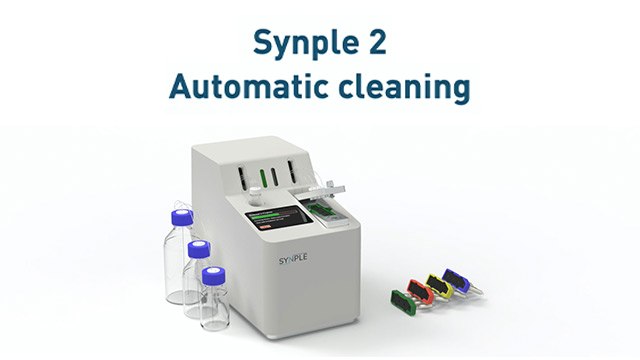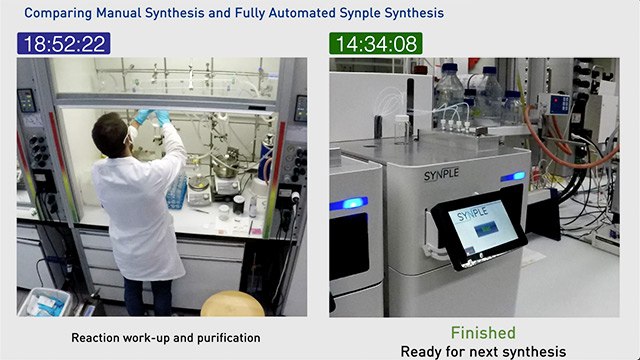Automated Chemical Synthesis
Automated chemical synthesis enables end-to-end handling of reaction setup, execution, workup, isolation, and purification by programmable systems. Using automation and digital controls, these platforms produce small molecules and other organic compounds with improved speed, efficiency, and reproducibility. Reducing manual steps can lower operator error and contamination risk, improve safety, and allow researchers to focus on experimental design and analysis.
In partnership with SynpleChem, we provide an automated synthesis platform for drug discovery, medicinal chemistry, and general chemical synthesis. The system combines a benchtop synthesizer with pre-filled reagent cartridges. Users add the starting material, select a cartridge, and start the run; the instrument manages reaction execution, workup, and product isolation/purification. An automated wash sequence prepares the instrument for subsequent runs and helps reduce cross-contamination, supporting parallel or sequential experiments and routine optimization.
Explore our wide selection of reagent cartridges featuring distinct reaction classes, with more than 40 different reagents:
- N-Heterocycle formation (SnAP) – converts a broad range of aldehydes into N-heterocycles
- Reductive amination – transforms aldehydes or ketones and primary or secondary amines into complex amines
- Protein Degrader formation – designed for PROTAC® synthesis with a variety of PEG linker lengths and either VHL or CRBN ligands
- Biotin tags – attaches Biotin tags to either aldehydes/ketones via reductive amination or amines via acylation
- Mitsunobu – forms carbon-carbon bonds through dehydrative coupling of a primary or secondary alcohol
- Boc protection – provices Boc protection of primary and secondary amines
- Boc deprotection – removes Boc protection of amines into free amine salts
- Fluorination – transforms primary and secondary alcohols into corresponding fluorinated product
- Silyl deprotection – removes silyl protecting groups
- Amide formation – couples amines and carboxylic acids
- Suzuki Coupling – couples aryl halides with aryl boronic acids
- Nosyl Protection – provides o-Ns protection of primary/secondary amines and amine salts
- Cbz Protection – provides N-Cbz protection of primary/secondary amines and amine salts
Related Resources
- Article: Synthesis Made Synple – Synple Automatic Synthesizer & Reagent Cartridges
Read the technical article to learn how Synple automated synthesizer reagent cartridges enable fully automated, cartridge-based workflows for organic transformations.
- eBook: A Grand Synthesis: Automation is Changing How Scientists Synthesize Chemicals
Download the ebook (developed with C&EN) to see how automated synthesis platforms streamline workflows and reduce time and resource use.
- Brochure: Synthesis Made Synple - Synple Chem - Automated Chemical Synthesis Platform
Download the brochure to get a detailed overview of the Synple 2 system, including its specifications, workflow steps, compatible cartridges, supported reaction types, setup instructions, and performance data.
- Article: SnAP Reagents
SnAP Reagents facilitate synthesis of saturated N-heterocycles for diverse structures.
- Article: Partial PROTACs
Protein Degrader Building Blocks are a collection of crosslinker-E3 ligand conjugates with a pendant functional group for covalent linkage to a target ligand.
External Resources
- Chemistry World Webinar: Automated Capsule Chemistry with Synple: Do More, Faster
Learn how automated synthesis technology allows discovery chemists to accelerate research and improve efficiency.
- Wiley Virtual Seminar: Chemputation, Digital Chemistry and Automated Synthesis
Discover a universal approach to chemical synthesis that translates all procedures to XDL that allows chemistry to be communicated universally.
- Webinar: Synthesis Automation with SYNTHIA™ & SynpleChem
Learn how SYNTHIA™ retrosynthesis software, combined with Synple’s automated synthesis technology, streamlines the route planning and execution of novel molecule synthesis. This approach accelerates drug discovery through customized and automatable workflows.
To continue reading please sign in or create an account.
Don't Have An Account?
